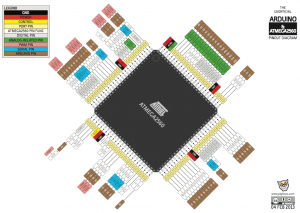The ATMEGA 2560
The ATMEGA 2560 is a high performance, low power 8 bit AVR RISC – based microcontroller manufactured by Atmel.
Specifications
- CPU 8 bit AVR
- 256 KB of ISP Flash Memory
- 8 KB SRAM
- 4KB EEPROM
- 86 general purpose I/O lines
- 32 general purpose working registers
- 5 SPI (Serial Peripheral Interface)
- 32 KHz RTC (real time counter), six flexible timer/counters with compare modes
- 15 PWM channels
- 15 analog inputs
- 16 output compare channels
- 4 input capture channels
- 4 UARTs for serial and parallel communications
- byte oriented 2-wire serial interface with 12 channels
- 16-channel 10 bit- A/D converter
- JTAG interface for on chip debugging, this is a standard test access protocol
- 16 MIPS at 16 MHz, approximate throughput of 1 MIPS per MHz
- 4.5 to 5.5 operating voltage
- Temperature ranges from -40 to 85 Celsius
I chose this microcontroller over the other more popular ones, because this one got quite a bit of add-ons. It’s powering the new Arduino Mega 2560 which replaced the Arduino Mega. This microcontroller single chip design is extensively used in industrial communications solutions; Ethernet based systems. An excellent wireless communications performer with transceiver bundles, and modules.
So what’s AVR? The AVR is a single chip micro-controller developed by Atmel in 1996. The AVR is one of the first micro-controller families to use on-chip flash memory for program storage, as opposed to a one -time programmable ROM used by other micro-controllers. Still what AVR stands for is not clear, so I kept looking. The name AVR is not an acronym and does not stand for anything in particular. The creators of the AVR give no definitive answer as to what the term “AVR” stands for. However, it is commonly accepted that AVR stands for Alf (Egil Bogen) and Vegard (Wollan)’s RISC processor, two students at the Norwegian Institute of Technology (NTH). developed the AVR at a local ASIC house in Trondheim, Norway called Nordic VLSI at the time, where Bogen and Wollan were working as students. It was known as a RISC (Micro RISC- AVR).
RISC – Reduced Instruction Set Computing, a CPU design.





